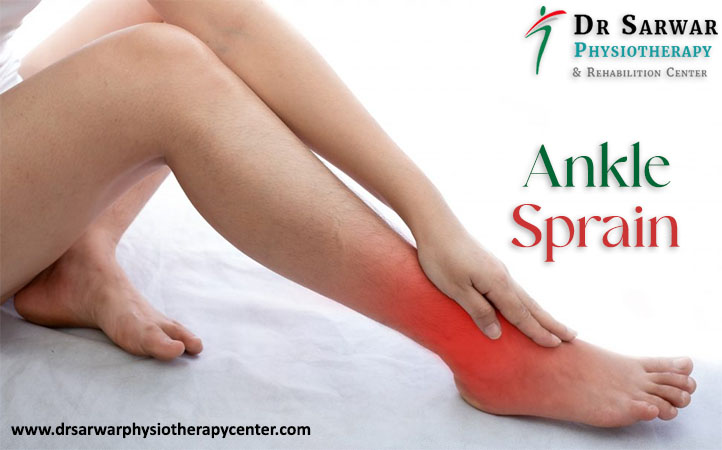You know that sharp pain, that happens after an ankle sprain? An ankle sprain is a sudden movement, which leads to a strain or tear of ligaments in a joint. This type of sprain is the most common injury in the universe of musculoskeletal pathology.
The ankle is the joint between the foot and the leg and is made up of 3 bones: tibia, fibula, and talus. Patients tend to disregard these injuries, which can cause local symptoms and even permanent sequelae.
Ankle sprain is a common cause in young adults (ages 15 to 35) and athletes. According to physiotherapy doctor in Dwarka, ankle sprain is one of the most frequent diseases in orthopedic emergencies. It occurs most frequently in soccer, basketball, volleyball and athletes, accounting for about 10% to 15% of all sports injuries.
In an ankle sprain, the anatomical structures of the joint are usually affected, such as muscles, tendons and, in more severe cases, bones and cartilage, which can progress to ligament complications.
In a normal state, the ligaments, which are elastic structures, stretch to their limit, then return to their initial position. Ligaments have a specific range of motion that allow joint stability.
Ligaments are made up of whitish fibrous connective tissue (contains collagen) and have the function of joining two or more bones, protecting, and stabilizing the body’s joints and acting as shock absorbers.
In this text we will present everything you need to know about an ankle sprain, the main causes, its symptoms and the most appropriate form of treatment with promising results. Keep reading!
Classification of Ligament Injuries
Depending on how affected the ligament is and the degree of damage, an ankle sprain can range from mild to severe. Pain and swelling are common; however, it is possible to walk with little pain. In a more severe sprain, tenderness and bruising around the ankle may occur, causing difficulty in walking.
Grade I (mild): ligament strain occurs. Generally, the patient should feel improvement after three days, with asymptomatic or little tissue pain.
Grade II (moderate): partial tear with mild laxity and moderate pain, instability, swelling, and tenderness.
Grade III (severe): complete rupture, severe pain, with local swelling, significant laxity and, most of the time, the joint is unstable.
How an Ankle Injury Occurs
In ankle injuries, there is an accidental inversion of the foot with plantar flexion, especially when stepping on an irregular step or surface, using unstable shoes, such as high heels or even falling from one’s own height.
This anomalous movement causes an injury that starts in the anterior talofibular ligament, and can progress to an injury to the calcaneofibular ligament, with the increase in the energy of the trauma.
Signs and Symptoms of Ankle Sprain
In ankle sprain, pain occurs in the foot, from mild to very severe.
Usually, the ankle immediately begins to swell, and ecchymosis and joint effusion may develop in the area of swelling. The pain increases with movement and is tender to the touch.
The more severe the injury, the more visible the signs.
What are the main causes of Ankle Sprain?
There are many causes, and some factors may involve the appearance of the lesion, such as:
- sudden movements with the feet;
- Wearing inappropriate footwear, such as very high heels;
- Carrying out physical activity without preparation;
- loose ligaments;
- Walking on uneven ground;
- Weak muscles;
- Nerve injuries;
- Previous injuries.
Diagnosis
The orthopedic professional usually performs the medical diagnosis of ankle sprain, as it is the most suitable to deliver the result and carry out a reliable analysis of the injury, through the patient’s clinical history, complementary exams that help in the exact and precise diagnosis of the injury.
Some of them are:
- X-ray: allows the orthopaedic doctor in Delhi to obtain images with details of the region where the injury occurred, helping the specialist to exclude the possibility of a fracture in any bone of the foot or located in the ankle itself, thus allowing an assertive and complete diagnosis;
- Magnetic Resonance Imaging: the specialist requests it when there is a more serious injury, which involves fractures in the articular bone;
- Ultrasonography: allows observation of the ankle ligament while moving it, making it possible to visualize details of the joint injury;
- Tomography: useful for a better assessment of the fracture pattern.
Types of Treatment for Ankle Sprains
Physiotherapy in Dwarka is the most effective method of treatment for sprains, especially when it comes to proprioceptive re-education, as it will prevent instability and new fractures.
Treatment can be either conservative or surgical. The choice depends on the severity of the injury. Conservative treatment will depend on the type and severity of the trauma.
The conservative protocol follows:
- Rest: Do not support with the fractured limb;
- Ice: Place on the injury site for 15 minutes every 2 hours for the first few days;
- Compression: Bandages or elastic stockings help control edema;
- Elevation: Keep the affected limb at heart level;
- Immobilization: Immobilizing boot or plastered splint always in the initial care;
- Medications: To control swelling and relieve pain in the first few days of trauma, such as anti-inflammatories and analgesics.
In the minority of cases, the treatment is surgical. However, depending on the type of fracture, more than one surgical intervention, called ligament repair, may be required.
When surgery is performed in the chronic phase, with patients with a history of repeated sprains, it is usually performed by fixing the injured ankle ligament to the bones, using implants such as anchors, which can be metallic or made of bioabsorbable material.
Conclusion
It is noted that from the articles studied there are different types of treatment for ankle injuries , such as the use of splints, immobilization with functional orthosis, elastic bandage, and others. The intervention criterion after an ankle sprain can be chosen according to the time of the event.
It is likely that there is an understanding in the literature when selecting the best practices for the treatment of injuries in the region, an understanding that assesses that the faster the choice of treatment type, the faster the patient’s recovery, says the best physiotherapist in Dwarka.
- Herniated disc and physiotherapy
- Physiosexology: how can physiotherapy help your sexual health?
- Importance of physiotherapy in stroke
- The role of physiotherapy in cardiovascular rehabilitation
- Physiotherapy for back pain and low back pain
- What are trigger points and how are they treated?
- Physiotherapy treatment for adhesive capsulitis
- Physiotherapy in temporomandibular joint dysfunctions
- Meniscus tear and physical therapy
- Physiotherapy treatment for patients with spinal cord injury


 Comments (
Comments ( Category (
Category ( Views (
Views (